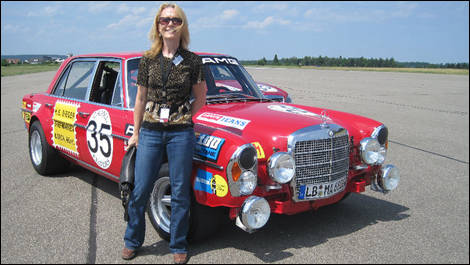We're on a landing strip in the middle of a cornfield near Stuttgart. There's a very surreal "Field of Dreams" quality to the scene, because although we're here to test the new Mercedes-Benz S 63 AMG, standing on a platform surrounded by a sea of green, waving fronds is a piece of automotive history – the 300 SEL 6.8 AMG, otherwise known as "The Red Pig."
It's been my experience that the German car company types aren't much for humour, so I wasn't really expecting an answer when I pointed to the celebrated racer and said "Can we drive that?"
Surprisingly, the response was "Ja, you can drive it."
Seriously. The great-grandaddy of AMG, the car that started the entire legacy of Mercedes-Benz's performance arm – and I'm actually going to have the chance to experience it from behind the wheel?
Well, as it turns out, not exactly.
Tragically, the Red Pig – after stunning the racing world by defeating sports cars a fraction of its size and weight in the 1971 24 Hours of Spa – was sold to an airplane manufacturer to test fighter jet landing gear.
Say what?
Apparently, the original vehicle, which should be enjoying its rightful place in the company's museum among other priceless and historically significant vehicles, was sold to Matra, the French aircraft manufacturer. They then proceeded to cut a bloody great hole in its floorpan and the Red Pig spent its final days hurtling down runways, while tires were lowered from its belly to determine their ability to withstand the 200-mph contact with the tarmac. Where it eventually ended up is, alas, unknown.
Acknowledging that they'd made a most unfortunate error – Mercedes undertook the task of recreating the Red Pig as accurately as possible – with the intention of displaying it at the 2006 Geneva Motor Show. It was a difficult job, as the original car was a base model without air conditioning or sunroof, very few of which were ever produced.
At last, a suitable base car was located in Berlin, while Mercedes scoured all of Western Europe to procure the various other matching parts needed for the project. Underhood is the same bored-out, 6.8L mill with 420 hp – an astonishing output for its era.
Outrageously flared wheel arches frame lightweight magnesium wheels, its boxy prow bristles with an arsenal of lights. Emblazoned across the red flanks and hood are the same decals worn by the original.
Although it was obviously a letdown to know we were looking at a mere replica, it was comforting that such a painstakingly accurate recreation exists to pay tribute to the lost icon.
Still, I'll admit to butterflies when I cranked open the door and took in the vintage bucket racing seats, cheesy wood trim and long, slender, ball-topped shifter.
After being repeatedly cautioned to take it easy ("you vill be careful, ja?") I turned the key and the Red Pig burst to life in a cacophony of rude, raspy blatts, bangs and pops. Gripping the skinny wheel, and shifting to drive (ja, it was automatic, but who cares?) we thundered down the runway, stinking of race fuel and trumpeting like an off-key bull elephant.
Obnoxiously noisy – mechanical and rough, with tugboat-like steering and rudimentary braking, the porky sedan nonetheless charmed me to the core. I emerged from the cockpit with the sappy grin of the recently smitten. I wasn't the only one.
That a mere replica could induce such feelings is a poignant reminder of the importance of historical preservation.
The Red Pig may be gone forever but its legacy remains.
It's been my experience that the German car company types aren't much for humour, so I wasn't really expecting an answer when I pointed to the celebrated racer and said "Can we drive that?"
Surprisingly, the response was "Ja, you can drive it."
Seriously. The great-grandaddy of AMG, the car that started the entire legacy of Mercedes-Benz's performance arm – and I'm actually going to have the chance to experience it from behind the wheel?
Well, as it turns out, not exactly.
Tragically, the Red Pig – after stunning the racing world by defeating sports cars a fraction of its size and weight in the 1971 24 Hours of Spa – was sold to an airplane manufacturer to test fighter jet landing gear.
Say what?
Apparently, the original vehicle, which should be enjoying its rightful place in the company's museum among other priceless and historically significant vehicles, was sold to Matra, the French aircraft manufacturer. They then proceeded to cut a bloody great hole in its floorpan and the Red Pig spent its final days hurtling down runways, while tires were lowered from its belly to determine their ability to withstand the 200-mph contact with the tarmac. Where it eventually ended up is, alas, unknown.
 |
| Mercedes-Benz 300 SEL 6.8 AMG |
Acknowledging that they'd made a most unfortunate error – Mercedes undertook the task of recreating the Red Pig as accurately as possible – with the intention of displaying it at the 2006 Geneva Motor Show. It was a difficult job, as the original car was a base model without air conditioning or sunroof, very few of which were ever produced.
At last, a suitable base car was located in Berlin, while Mercedes scoured all of Western Europe to procure the various other matching parts needed for the project. Underhood is the same bored-out, 6.8L mill with 420 hp – an astonishing output for its era.
Outrageously flared wheel arches frame lightweight magnesium wheels, its boxy prow bristles with an arsenal of lights. Emblazoned across the red flanks and hood are the same decals worn by the original.
Although it was obviously a letdown to know we were looking at a mere replica, it was comforting that such a painstakingly accurate recreation exists to pay tribute to the lost icon.
Still, I'll admit to butterflies when I cranked open the door and took in the vintage bucket racing seats, cheesy wood trim and long, slender, ball-topped shifter.
After being repeatedly cautioned to take it easy ("you vill be careful, ja?") I turned the key and the Red Pig burst to life in a cacophony of rude, raspy blatts, bangs and pops. Gripping the skinny wheel, and shifting to drive (ja, it was automatic, but who cares?) we thundered down the runway, stinking of race fuel and trumpeting like an off-key bull elephant.
Obnoxiously noisy – mechanical and rough, with tugboat-like steering and rudimentary braking, the porky sedan nonetheless charmed me to the core. I emerged from the cockpit with the sappy grin of the recently smitten. I wasn't the only one.
That a mere replica could induce such feelings is a poignant reminder of the importance of historical preservation.
The Red Pig may be gone forever but its legacy remains.


